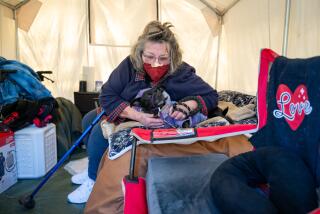Stroll Patrol
- Share via
ANAHEIM — Bill Moss is the kind of cop who doesn’t walk away from a job well done.
Which is why, two years after he and a group of Kodiak Street residents drove a gang away, Moss is on a personal crusade to keep the street safe--even though he’s been moved to a police job elsewhere in Anaheim.
After work one evening a week, he returns to Kodiak, joining about 20 men, women and children to walk through the area, flashlights on and eyes peeled for signs of trouble.
Since the walks began, apartment managers have evicted more than a dozen suspected drug dealers from the neighborhood. Security lights have been installed in once-dark alleys. Garbage that littered the street is gone, save for the occasional overflowing trash bin promptly tidied up by Moss’ neighborhood brigade. And the gang that had taken over is in retreat.
“There’s a lot to that, saying that if you hire somebody with passion, you can do so much. And [Moss] definitely has passion for his job,” said John Poole, Anaheim code enforcement manager. “Passion is what it takes for this type of work, where you can’t turn things around overnight, and it has worked.”
The walks have done more than discourage crime. In a neighborhood in which most people did not know one another beyond a smile or a wave, there are now friends who rely on each other. With the shootings, stabbings and drug dealing that the area had become known for almost gone, so is the stigma that drove up vacancy rates and dashed morale.
“Don’t tell him I said so, but Bill Moss is our cop. He’s our policeman. He’s the kind of guy you’d go to the mat for, and we know he’d do the same for this place,” said Earle Moriarty, who participates in what residents call their weekly Kodiak Walk.
The Kodiak Street walks have changed Moss’ career and outlook on his job almost as much as they have changed the neighborhood.
The soft-spoken, friendly former Marine said he never realized before he got involved with the people of the street how much preventing crime, not just responding to it, meant to him. Last spring, the then-patrol officer won the 1996-97 Anaheim Police Department Community Policing Officer of the Year Award for his effort.
“The whole thing just made me feel like a million bucks because of the fact that I have actually impacted these people’s lives,” Moss said, explaining the attachment that keeps him coming back for the walks week after week.
“A lot of police work, you never really get that gratification. But in this case, you get to see it.”
These days, the walk is part social hour, part community chat session, and a way for neighbors to confront their fears about the deterioration they have staved off, at least for now. Children with dogs tag along behind parents, eagerly searching out graffiti for their moms and dads to blot out with the rainbow array of spray paint the group carries.
When Moss and residents started walking the street, gangs with knives and guns hid in the dark places, and garbage was strewn across the pavement.
The so-called Kodiak Street Gang had claimed the street and surrounding alleys as their turf. Police were called to the area three and four times a day. Robberies at knife- and gunpoint were common.
“It used to be on Saturday nights I could sit in the spa in my backyard listening to the gunfire,” resident Earl Kelso said. “I didn’t want my wife to walk outside at night. We’ve lived here a long time. We own property here. When we moved here, it was safe. Then, everything started to change.”
Kodiak Street lies in an area of older, ranch-style homes, spacious condos and smaller apartments at the east end of Anaheim known as the Canyon. With its wide lawns, access to parks and bike trails and largely middle-class profile, the neighborhood historically has not been rough.
When Moss was assigned to Kodiak Street in July 1995, however, it had become dangerous. Longtime residents, alarmed about increasing crime, had tried to organize their own neighborhood walks. But the first time they took to the street, gang members approached them menacingly, and the neighbors turned back.
“We had some scary confrontations with the gang, really menacing,” resident Ron Breach said. “Really menacing. I couldn’t believe this was my neighborhood.”
That’s when Moss came up with a ruse to turn the tables. With the permission of his boss, he and a group of police officers walked Kodiak Street one evening, masquerading as residents.
“We started at the south end of Kodiak, and it was classic,” Moss recalled with a chuckle. “Less than a minute later, one of the kids came up to me, got right in my face and said, ‘Get out of here. This is my street.’ ”
While police confronted the gang members, residents stood behind the windows of their houses videotaping the youths painting graffiti on walls and breaking windows. By the end of the evening, the youth who confronted the undercover officers had been arrested, along with three companions charged with malicious misconduct and possession of narcotics.
But Moss, a 25-year veteran police officer, said he knew his work on Kodiak Street was just getting started. Meeting with demoralized residents, he convinced them in November 1995 to start walking Kodiak Street again as a group, this time with him along.
Meeting one night a week on a staggered schedule to confound the gang members, residents start out their walks in the parking lot outside a doughnut shop at one end of Kodiak Street. If enough people show up, they fan out into two or three groups. On some nights, their ranks are thin. On average, about 10 people attend. The routine is always the same.
Residents shine flashlights into dark corners, noting garbage that needs to be picked up, broken glass to be cleared away and lights that are out. On a recent night, Moss didn’t wait for city cleanup crews, choosing instead to haul a discarded recliner to a nearby trash bin.
On the occasional night when Moss can’t make it, residents feel safe enough and confident enough to head out on their own. A police helicopter, alerted by Moss, detours from its regular rounds and flies over Kodiak Street on those nights, the pilot often lighting the walkers with powerful spotlights.
“We find out about each other, and, meanwhile, we take care of the neighborhood,” resident Mike Mora said. “You establish a sense of community, you get to know the neighborhood. And I think you can almost get to stop trouble before it happens.”
The Kodiak experience convinced Moss, 49, to try his hand at community policing as a career. Officers on community policing details spend the bulk of their time working with communities to discourage criminal activity, rather than responding to crime scenes.
In July, he took a new job doing just that in West Anaheim.
But Moss always comes back for his Kodiak Walk.
“I know that in all honesty I will probably be doing the walk until I retire. I will somehow find a way to do it because, for me, getting rid of the bad guys here, seeing the changes is the most worthwhile thing I’ve done in 25 years,” Moss said.
“The walks are not about just me, and they are not just about [residents]. It’s everybody walking together.”
More to Read
Sign up for The Wild
We’ll help you find the best places to hike, bike and run, as well as the perfect silent spots for meditation and yoga.
You may occasionally receive promotional content from the Los Angeles Times.






